 ,1, Wen-Qi Niu
,1, Wen-Qi Niu ,1, Yu-Fei Wang
,1, Yu-Fei Wang ,2,∗, Han-Qing Zheng
,2,∗, Han-Qing Zheng ,1,31Department of Physics and State Key Laboratory of Nuclear Physics and Technology,
,1,31Department of Physics and State Key Laboratory of Nuclear Physics and Technology, 2Helmholtz Institut für Strahlen- und Kernphysik,
3Collaborative Innovation Center of Quantum Matter, Beijing,
First author contact:
Received:2020-05-16Revised:2020-06-19Accepted:2020-06-22Online:2020-09-29

Abstract
Keywords:
PDF (474KB)MetadataMetricsRelated articlesExportEndNote|Ris|BibtexFavorite
Cite this article
Yao Ma, Wen-Qi Niu, Yu-Fei Wang, Han-Qing Zheng. How does the S11N*(890) state emerge from a naive K-matrix fit?. Communications in Theoretical Physics, 2020, 72(10): 105203- doi:10.1088/1572-9494/aba25d
In a series of recent publications [1-3], it is suggested that there exists a subthreshold resonance in the S11 channel of πN scattering, with $M-{\rm{i}}{\rm{\Gamma }}/2=895(81)-{\rm{i}}164(23)$ MeV. The result is completely novel and is obtained based on an approach([4-6]) with full respects to fundamental principals of S-matrix theory such as unitarity, analyticity and consistent with crossing symmetry([7, 8]). The approach is much superior to conventional unitarization approximations, such as K-matrix method or variations of Padé approximation (for the discussion, see for example [9, 10]).
Specifically, in the regime of Peking University (PKU) representation [1-3], input the left-hand cut from chiral perturbation theory results, while the inelasticity and known poles are fixed from experimental data. Due to the negative definite contributions from left-hand cut to the phase shift, and positive definite contributions from known resonances and inelasticity, we claim that a subthreshold resonance must exist, irrespective to the details of calculations, in S11 channel. Especially [3], gives a comprehensive analysis on not only the N*(890) pole but also the physics of all other S- and P-wave channels.
Nevertheless, those works have still received some queries: firstly, why do many previous works do not find significant effects from N*(890) resonance? Secondly [1-3], inputs the left-hand cut only from chiral perturbation theory, which may not work well in the region far away from threshold.
The aim of this paper is to make a further analysis in the conventional K-matrix approach, to examine and to understand why the N*(890) was missed in previous researches, and how it can appear even in a simple K-matrix analysis, if one be respectful to the analyticity property of scattering amplitude offered by standard quantum field theory. We hope the analysis made in this paper be helpful to convince the physics community to accept the existence of the N*(890) resonance.
To begin with, let us start from the standard coupled channel K-matrix formula:
Basically the only requirement on K is that it is a real symmetric matrix in the physical region in order to fulfill unitarity. Hence we start from a simple form (herewith we call it Fit I):
Using equation (
Figure 1.
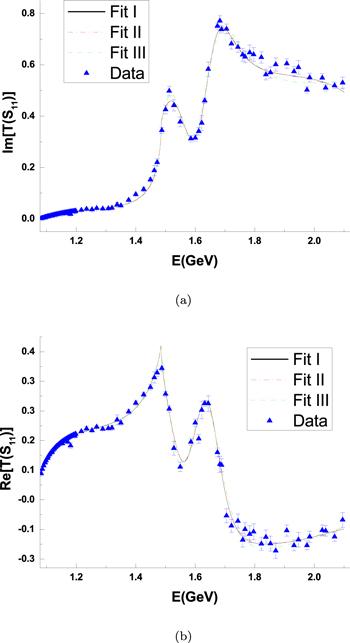 New window|Download| PPT slide
New window|Download| PPT slideFigure 1.Fit of GWU data upto $\sqrt{s}=2.1$ GeV, (a) $\mathrm{Im}T$, (b) $\mathrm{Re}T$. Fit I: solid line (black); Fit II: dotted-dashed line (red); Fit III: dashed line (green).
Table 1.
Table 1.Fit I: poles obtained using equation (
| Sheets | Pole positions on $\sqrt{s}$ plane in unit of GeV |
|---|---|
| I | 1.36 − 0.65i |
| II | 1.68 − 0.07i; 0.73 − 0.19i |
| III | 1.68 − 0.07i; 0.92 |
| IV | 1.529 − 0.016i |
New window|CSV
Table 1 may deserve a few words of explanation: experienced readers will quickly recognize that poles $1.68-{\rm{i}}0.07$(II) and $1.68-{\rm{i}}0.07$(III) are of N*(1650), whereas $1.529-{\rm{i}}0.016$(IV) and 0.92(III) are of N*(1535) since, as is well known, the former mainly couples to πN while the latter mainly couples to ηN. Though their pole locations may be rather poorly determined, the main interests here is however to investigate the N*(890) pole. Hence we actually do not pay much attention to these well established resonances. Similar to [1-3], in figure 2 phase shifts contributed from different sources are plotted using PKU representation; their sum equals to the fit curve or experimental data, as it should.
Figure 2.
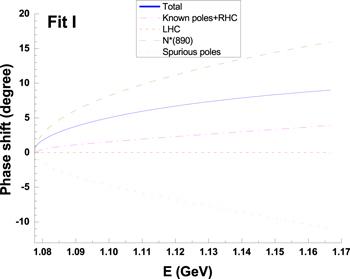 New window|Download| PPT slide
New window|Download| PPT slideFigure 2.Fit I: different contributions to the phase shift near πN threshold.
We summarize major outputs from Fit I: The known poles and right hand inelastic cut which begins at the ηN threshold cannot fit the phase shift data. That indicates missing contributions from other sources have to exist.
The left-hand cut contribution is nearly zero, which is of course not correct as will be discussed at some lengths below.
Below πN threshold there exists a resonance pole providing a large positive phase shift. Meanwhile a spurious pole on first sheet provides a negative phase shift.
One great advantage of the PKU representation is that different contributions to the phase shift are separable and additive, hence one can calculate different contributions to the phase shift, especially that from the background term in πN channel, $f(s)\equiv \tfrac{\mathrm{ln}{S}_{11}(s^{\prime} )}{2{\rm{i}}{\rho }_{1}(s^{\prime} )}$, with ${S}_{11}\equiv 1+2{\rm{i}}{\rho }_{1}{T}_{11}$:4(4 For more discussions on related topics, one is referred to [1-3].)
Figure 3.
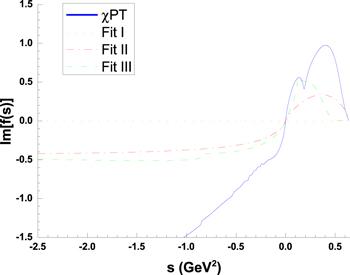 New window|Download| PPT slide
New window|Download| PPT slideFigure 3.Different estimations on the spectral function of left-hand integral: the solid (blue) line depicts the $\chi {PT}$ result at $O({p}^{3})$ [3]; the dotted straight line (orange) is from Fit I; dotted-dashed (green) line is from Fit II; dashed (green) line is generated by Fit III. Small fluctuations in these curves are either from nearby (spurious) singularities or from numerical instabilities and should be ignored.
It is actually easy to understand why R becomes too small in Fit I. Since the only source of branch point singularity in S11 before the inelastic effect in ρ2 is switched on, is ${\rm{i}}{\rho }_{1}(s)$, and remember that on the left cut ${\rm{i}}{\rho }_{1}(s+{\rm{i}}\epsilon )=-{\rm{i}}{\rho }_{1}(s-{\rm{i}}\epsilon )$, the S-matrix constructed as such is also unitary on the left! Hence the spectral function of the left-hand integral vanishes. This annoying property of S is due to the over-simplification of equations (
Fit II:
As discussed above, the vanishing of the left-hand cut contribution comes from a poor approximation (on-shell approximation). In order to parameterize the amplitude with better analyticity property, one should at least pick up the dispersive part together with the absorptive part. From equation (
We therefore unitarize the amplitude in the following way:
Nearby poles found from Fit II are listed in table 2. We also plot $\mathrm{Im}(\tfrac{\mathrm{ln}{S}_{11}(s^{\prime} )}{2{\rm{i}}{\rho }_{1}(s^{\prime} )})$ read off from Fit II in figure 3. The scattering length does not change much: $a\simeq 164.11\times {10}^{-3}{m}_{\pi }^{-1}$. We find significant improvement on the left-hand cut. It has now a similar behavior with the $\chi {PT}$ calculation in the validity region of the latter, meanwhile contributes still negatively to the integral of f defined in equation (
Figure 4.
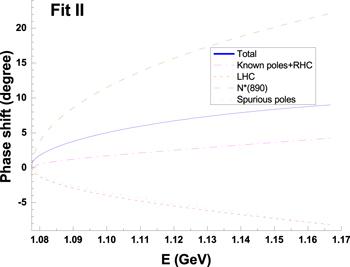 New window|Download| PPT slide
New window|Download| PPT slideFigure 4.Different contributions to the phase shift in Fit II.
Table 2.
Table 2.Fit II: poles obtained using equation (
| Sheets | Pole positions on $\sqrt{s}$ plane in unit of GeV |
|---|---|
| I | 1.85 − 0.29i |
| II | 1.66 − 0.04i; 0.77 − 0.23i |
| III | 1.66 − 0.06i; 1.50 − 0.05i |
| IV | 1.53 − 0.01i |
New window|CSV
Comparing Fit II with Fit I we observe that the correct use of analyticity in the s-channel, by recovering the dispersive part of the kinematic factor, leads to much improved predictions on the left cuts, the much suppressed spurious pole contribution, and stronger evidence for the existence of N*(890). Inspired by this, one wonder whether the inclusion of t-channel and u-channel cuts could further improve the fit results. We do this in the following Fit III.
Fit III:
We add in the K-matrix the tree diagram contribution of t-channel ρ meson and u-channel nucleon exchanges (though the latter's effect is very small). It now reads,
Figure 5.
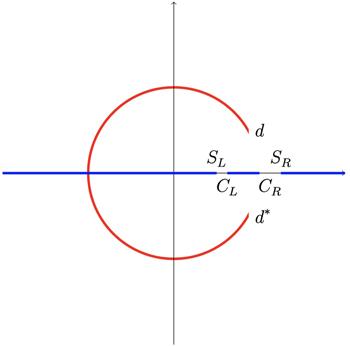 New window|Download| PPT slide
New window|Download| PPT slideFigure 5.The left cut caused by t-channel ρ meson exchange (circular arc); u-channel exchange (line segment from cL to cR [3]).
Figure 6.
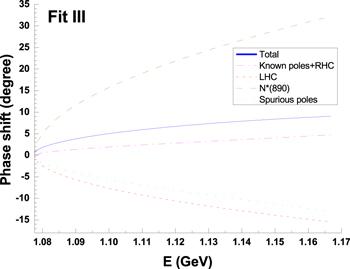 New window|Download| PPT slide
New window|Download| PPT slideFigure 6.Fit III: the phase shift near πN threshold.
Table 3.
Table 3.Fit III: poles obtained using equation (
| Sheets | Pole positions on $\sqrt{s}$ plane in unit of GeV |
|---|---|
| I | 1.35 − 0.58i |
| II | 1.67 − 0.07i; 0.93 − 0.27i |
| III | 1.65 − 0.09i; 1.53 − 0.07i |
| IV | 1.54 − 0.01i |
New window|CSV
The spectral function read off from Fit III is plotted in figure 3. It is seen that the value of the spectral function now gets more closed to the result in [3], comparing with the Fit II solution in the small $| s| $ region, in the sense that it also produces the circular cut. It is even more important to stress that, the investigation here further justifies the strategy adopted in [1-3], i.e. to use a cut-off parameter to regulate the ‘resonance region' contribution to f(s). Since the ‘resonance region' contribution gives the same sign as comparing with that from perturbation region, the strategy taken in [1-3] will not be bad, as the fit decides the cut-off parameter and, after all, the location of the N*(890) pole will not be annoyed much by such an uncertainty. Numerically, here we obtain $R(\mathrm{left}\,\mathrm{cut})\simeq 0.25\,{\rm{fm}}$, $R(\mathrm{circular}\,\mathrm{arc})\simeq 0.10\,{\rm{fm}}$, their sum is closer to the fit value obtained in [3]. Also, the resonance pole below threshold provides a larger phase shift, see figure 6. Nevertheless the contribution of spurious pole is not found to be further suppressed comparing with Fit II.
At last one would like to fit the data by getting rid of spurious poles and by borrowing the left cuts (both the cut $(-\infty ,{s}_{L}]$ and the circular arc), i.e. to use predictions on ‘left-hand cuts' as an input in applying the PKU representation. The fit to the data is achieved without the need of any spurious poles and cut-off parameters. In this way one gets the subthreshold pole located at $\sqrt{s}\simeq 796(2)-109(8){\rm{i}}$ MeV—a result compatible with the results of [2, 3], even though the R value used here is only half of the value as estimated in [3]. Note that the location of N*(890) pole here numerically may not be necessarily better than the result in [3]; actually the aim of this paper is to show in another way that the strategy of [3] and the existence of N*(890), are reasonable.
To summarize, using a simple unitarization model, in this paper we have shown that, a better treatment of analyticity in the s channel dynamics has led to much improved analytic property on the left side. The inclusion of crossing symmetry, i.e. t- and u-channel resonance exchanges has further improved the quality of its predictions, in the sense that the results get closer to the $\chi {PT}$ ones in the validity region of the latter, as well as the emergence of the circular cut. Using the ‘best' model predictions on the left cuts (i.e. Fit III), one gets the pole location of the N*(890) being consistent with that of [1-3]. And the advantage now is the elimination of any cut-off dependence when evaluating left cut integrals. We think it is important to stress that all the pseudo-thresholds, i.e. ${({m}_{1}-{m}_{2})}^{2}$ are essentially due to relativistic effects and should not be ignored. In a non-relativistic theory, one may take these effects into account through introducing a sizable, physical, and negative background contribution to the phase shift [14].
We notice that in a paper by Döring and Nakayama [20] (see also [21]), the authors found a subthreshold pole at $\sqrt{s}\simeq 1031-203{\rm{i}}$ MeV in S11 channel, without further information on left cuts and spurious poles. The authors carefully quote: However, it is not clear if this state is genuine or a forced pole that mocks up the u- and t-channel subthreshold cuts that are not explicitly included in the present model. The investigations of this paper and [1-3] made it clear, we think, that the subthreshold resonance does not play a role of mocking up the crossed channels effects. The fact is just on the contrary—the former contributes a positive definite phase shift to counter balance the effects of the latter. We have actually witnessed similar things that happened in $\pi \pi $ scatterings and $\pi K$ scatterings, in most attractive channels [4-6, 22].
Acknowledgments
This work is supported in part by the National Nature Science Foundations of China under contract numbers 11975028 and 10925522, and by the Sino-German CRC 110 (Grant No. TRR110). The authors would like to thank Ulf-GMeißner for helpful discussions and suggestions.Reference By original order
By published year
By cited within times
By Impact factor
DOI:10.1140/epjc/s10052-018-6024-5 [Cited within: 9]
DOI:10.1007/s11467-018-0877-9 [Cited within: 1]
DOI:10.1088/1674-1137/43/6/064110 [Cited within: 23]
DOI:10.1016/j.nuclphysa.2003.12.021 [Cited within: 2]
DOI:10.1088/1126-6708/2005/02/043
DOI:10.1016/j.nuclphysa.2006.06.170 [Cited within: 2]
DOI:10.1088/1126-6708/2007/06/030 [Cited within: 1]
DOI:10.1016/j.physletb.2008.01.073 [Cited within: 1]
DOI:10.1016/S0370-2693(02)02312-2 [Cited within: 1]
DOI:10.1142/S0217751X07037160 [Cited within: 1]
DOI:10.1103/PhysRevD.32.1085 [Cited within: 1]
DOI:10.1016/j.physrep.2016.02.002 [Cited within: 2]
DOI:10.1103/PhysRev.74.131 [Cited within: 1]
DOI:10.1007/BF02815247 [Cited within: 2]
DOI:10.1016/j.aop.2013.06.001 [Cited within: 1]
DOI:10.1103/PhysRevD.87.054019
DOI:10.1103/PhysRevC.94.014620
DOI:10.1016/j.physletb.2017.04.039
DOI:10.1103/PhysRevC.96.055205 [Cited within: 1]
DOI:10.1140/epja/i2009-10892-4 [Cited within: 1]
DOI:10.1016/j.nuclphysa.2009.08.010 [Cited within: 1]
DOI:10.1016/S0375-9474(01)01100-9 [Cited within: 1]
DOI:10.1103/PhysRev.126.1596 [Cited within: 2]
DOI:10.1103/PhysRevC.60.024608 [Cited within: 1]
